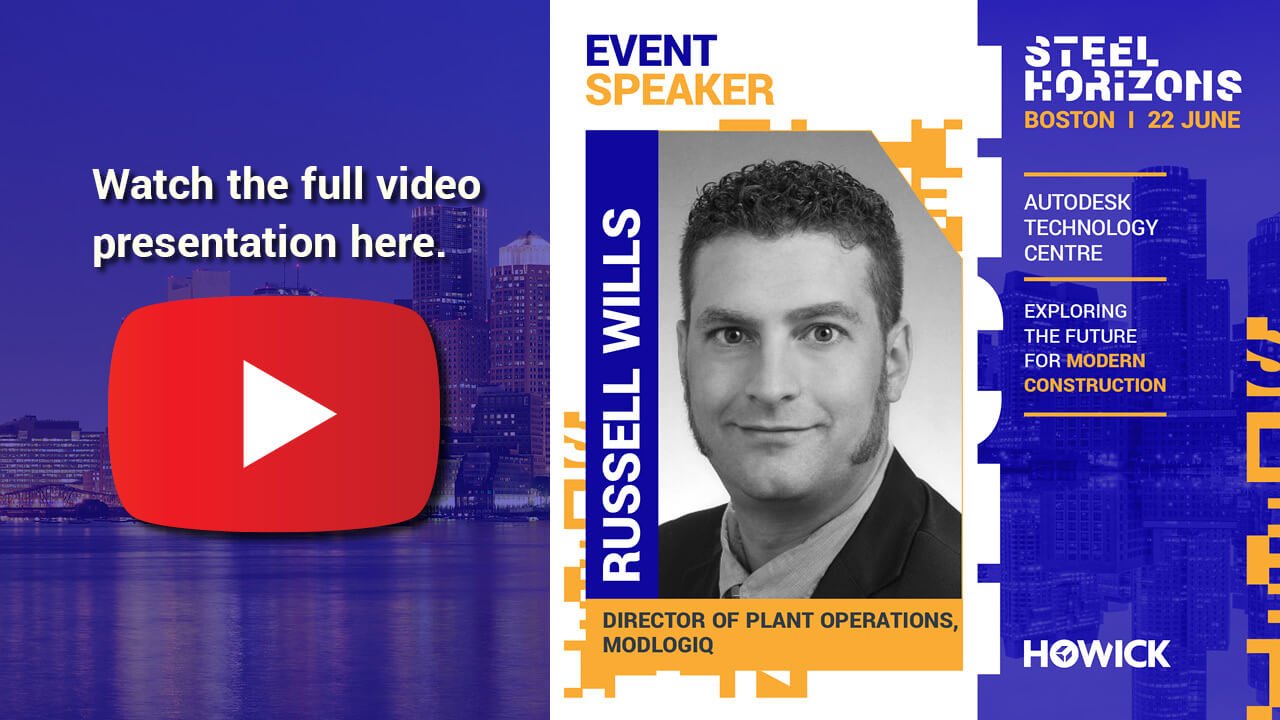STEEL HORIZONS | BOSTON Speaker Series 7 - Setting up a project for success from a manufacturing and erection standpoint with Russell Wills
⏱️ 5 min read
Step into the future of industrialized construction with our exclusive STEEL HORIZONS | BOSTON speaker series. In each post, we spotlight one speaker from our STEEL HORIZONS | BOSTON event and share their insights about the future of construction.
Next up is Russell Wills. Russell is Director of Plant Operations at MODLOGIQ, and has 20 years of experience in construction, offsite manufacturing and cold formed steel technology under his belt. He has a clear focus on researching better, faster, cleaner ways to build. In his presentation he explains how to set up an offsite project for success with detailed modelling and planning.
In his work at MODLOGIQ, Russell is involved in builds from pre-construction and 3D structural modelling, to site installation and beyond. Over 20 years in the industry he has learned how to ensure the entire process runs smoothly, often ahead of time and under budget.
In his discussion he shares the insights he has gained over the years and explains how getting the details and modelling right early will set you up for success, whatever you are building.
Focusing on details from day zero
Everything that happens in construction is about getting details right, especially when it comes to offsite methods. Russell explains how important it is that you do not start modelling until you have all the information available.
There may already be models in existence, but according to Russell, it is usually best to start from the bottom and work back up to create your own comprehensive model. Underneath any good model there should be data covering all the small details, from what goes into walls, to clearances, plumbing and electrical all the way down to the type of windows, brands, types of fasteners and screw patterns.
“All that data is embedded in your model, behind the scenes. When you pull that info out it is easily scripted and set to go where it needs to be.”
What this means is that when trade teams come in, they have all the information they need in one place, rather than looking at loads of different structural sheets. Lots of trades like to use certain products - so bringing them in early during the discovery phase helps to quantify all those materials in the model to ensure you get the details right early.
Control gates, processes and scheduling
Alongside a detailed model, Russell notes that certain processes and control gates are necessary, plus a robust schedule:
“The most important part of all offsite construction is your schedule. It allows you to drive and control the project from start to finish.”
“Setting deadlines helps keep everyone really accountable.”
Your schedule needs to be realistic but built on every different act coming together in a cumulative whole, from trade all the way to shipping and logistics.
Holding regular project meetings is another critical aspect of success, ensuring everyone involved in the project is focused on the end objective.
Russell has seen countless projects where installation crews do not know what goes where and how, and this can be disastrous to the efficiency of a project. It all goes back to the importance of the original detail and design being right at the outset.
With a good model, stacking modular units is easier: “You know where MEP closets and through-floor connections need to be. You have a bold corner or shaded areas that outline and set everything up from a coordination standpoint.”
“One thing you can’t control is manufacturing personnel and labour … so within manufacturing I have an operations crew who are jacks of all trades. A small crew that can jump in and run any part of the facility … to keep things moving.”
When it all comes together onsite
When the design and manufacturing work all comes together onsite, there is a need for more streamlined processes and control gates. Meet with the developer, installation crew and manufacturing team to go through erection sequences. This should include site specific information like:
-
Where cranes are set and what types of cranes are used
-
The maximum reach of cranes
-
Where trucks can go
-
Local restrictions, such as crane height limitations around airports or hospitals or quiet hours in residential areas.
The best way to avoid delays, cost blowouts and other problems is to get the modelling and detail right early on, according to Russell:
“To set a project up right … it really starts in the details. Do not start modelling until all the information is there. And ensure customers, clients and developers fully understand that it may take 6-8 months to get to manufacturing, but that’s what it takes to do it effectively.”
“Those cost savings and time savings, that ROI you get at the end of a project all depends on that first six months.”
